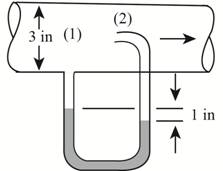
Concept explainers
(a)
The volume flow rate in the tube if the fluid in the tube is gasoline.
Answer to Problem 3.120P
The volume flow rate in the tube if the fluid in the tube is gasoline is
Given information:
The diameter of the tube in which fluid is flowing is
Concept Used:
The following figure shows the two sections where we apply the Bernoulli equation.

Figure-(1)
Write the expression for Bernoulli equation at section (1) and section (2).
Substitute
Here, pressure at section (1) is
Substitute
Write the expression for finding the pressure difference by using the manometer reading.
Here, the pressure difference between the limbs of manometer is
Write the expression for the flow rate.
Here, cross section area of the tube is
Write the expression for cross section area.
Here, diameter of the tube is
Calculation:
Substitute
Substitute
Substitute
Substitute
Conclusion:
Thus, the volume flow rate in the tube if the fluid in the tube is gasoline is
(b)
The volume flow rate in the tube if the fluid in the tube is nitrogen.
The volume flow rate in the tube if the fluid in the tube is nitrogen is
Given information:
The diameter of the tube in which fluid is flowing is
Concept Used:
Write the expression for ideal gas equation.
Here, the density of the fluid inside the tube is
Write the expression for discharge/flow rate.
Here, the cross section area of the tube is
Calculation:
Substitute
Substitute
Substitute
Substitute
Conclusion:
Thus, the volume flow rate in the tube if the fluid in the tube is nitrogen is
Explanation of Solution
Given information:
The diameter of the tube in which fluid is flowing is
Concept Used:
The following figure shows the two sections where we apply the Bernoulli equation.

Figure-(1)
Write the expression for Bernoulli equation at section (1) and section (2).
Substitute
Here, pressure at section (1) is
Substitute
Write the expression for finding the pressure difference by using the manometer reading.
Here, the pressure difference between the limbs of manometer is
Write the expression for the flow rate.
Here, cross section area of the tube is
Write the expression for cross section area.
Here, diameter of the tube is
Calculation:
Substitute
Substitute
Substitute
Substitute
Conclusion:
Thus, the volume flow rate in the tube if the fluid in the tube is gasoline is
(b)
The volume flow rate in the tube if the fluid in the tube is nitrogen.
Answer to Problem 3.120P
The volume flow rate in the tube if the fluid in the tube is nitrogen is
Explanation of Solution
Given information:
The diameter of the tube in which fluid is flowing is
Concept Used:
Write the expression for ideal gas equation.
Here, the density of the fluid inside the tube is
Write the expression for discharge/flow rate.
Here, the cross section area of the tube is
Calculation:
Substitute
Substitute
Substitute
Substitute
Conclusion:
Thus, the volume flow rate in the tube if the fluid in the tube is nitrogen is
Want to see more full solutions like this?
Chapter 3 Solutions
FLUID MECHANICS-PHYSICAL ACCESS CODE
 Elements Of ElectromagneticsMechanical EngineeringISBN:9780190698614Author:Sadiku, Matthew N. O.Publisher:Oxford University Press
Elements Of ElectromagneticsMechanical EngineeringISBN:9780190698614Author:Sadiku, Matthew N. O.Publisher:Oxford University Press Mechanics of Materials (10th Edition)Mechanical EngineeringISBN:9780134319650Author:Russell C. HibbelerPublisher:PEARSON
Mechanics of Materials (10th Edition)Mechanical EngineeringISBN:9780134319650Author:Russell C. HibbelerPublisher:PEARSON Thermodynamics: An Engineering ApproachMechanical EngineeringISBN:9781259822674Author:Yunus A. Cengel Dr., Michael A. BolesPublisher:McGraw-Hill Education
Thermodynamics: An Engineering ApproachMechanical EngineeringISBN:9781259822674Author:Yunus A. Cengel Dr., Michael A. BolesPublisher:McGraw-Hill Education Control Systems EngineeringMechanical EngineeringISBN:9781118170519Author:Norman S. NisePublisher:WILEY
Control Systems EngineeringMechanical EngineeringISBN:9781118170519Author:Norman S. NisePublisher:WILEY Mechanics of Materials (MindTap Course List)Mechanical EngineeringISBN:9781337093347Author:Barry J. Goodno, James M. GerePublisher:Cengage Learning
Mechanics of Materials (MindTap Course List)Mechanical EngineeringISBN:9781337093347Author:Barry J. Goodno, James M. GerePublisher:Cengage Learning Engineering Mechanics: StaticsMechanical EngineeringISBN:9781118807330Author:James L. Meriam, L. G. Kraige, J. N. BoltonPublisher:WILEY
Engineering Mechanics: StaticsMechanical EngineeringISBN:9781118807330Author:James L. Meriam, L. G. Kraige, J. N. BoltonPublisher:WILEY





